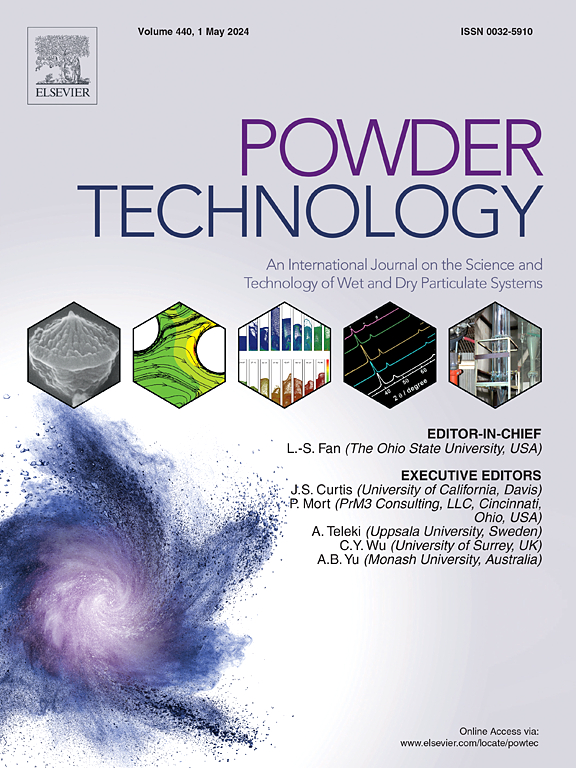不同直径硼/高氯酸铵/聚偏氟乙烯高能复合微球微爆燃烧特性
IF 4.5
2区 工程技术
Q2 ENGINEERING, CHEMICAL
引用次数: 0
摘要
硼基高能复合燃料由于其高能量密度,在炸药中得到了广泛应用。采用超声悬浮激光点火系统,研究了直径为400、450、500、600和700 μm的硼/高氯酸铵/聚偏氟乙烯(B/AP/PVDF)高能复合燃料微球的火焰特性、发射光谱和燃烧温度,并利用扫描电镜(SEM)分析了微球的表面形貌和内部结构。微球的燃烧经历了发展燃烧、稳定燃烧和下降燃烧三个阶段。在整个燃烧过程中观察到微爆炸。值得注意的是,检测到显著的BO₂发射光谱。随着微球直径的增大,比火焰面积和比光谱积分先增大后减小,在微球直径为600 μm时达到峰值,分别为3.73 mm−2和0.256 μm−2,表明能量释放效率最高。微球呈近球形形态,B、AP和PVDF组分分布均匀。研究微球的微爆炸燃烧特性及反应机理,建立单个微球的物理燃烧模型,确定能量释放效率最高的最佳粒径。研究结果为硼基复合燃料的制备和应用提供了有价值的实验数据和科学指导。本文章由计算机程序翻译,如有差异,请以英文原文为准。

Micro-explosion combustion characteristics of boron/ammonium perchlorate/polyvinylidene fluoride high-energy composite microspheres with different diameters
Owing to their high energy densities, boron-based energetic composite fuels are widely utilized in explosives. In this study, the flame characteristics, emission spectra, and combustion temperatures of boron/ammonium perchlorate/polyvinylidene fluoride (B/AP/PVDF) energetic composite fuel microspheres with five different diameters (400, 450, 500, 600, and 700 μm) were investigated using an ultrasonic suspension laser ignition system, with the surface morphology and internal structure of the microspheres analyzed using scanning electron microscopy (SEM). The combustion of the microspheres proceeded through three distinct stages: developing combustion, steady combustion and declining combustion. Micro-explosions were observed throughout the combustion process. Notably, significant BO₂ emission spectra were detected. However, the specific flame area and specific spectral integral initially increase and then decrease as the microsphere diameter increases, peaking at a diameter of 600 μm, with values of 3.73 mm−2 and 0.256 μm−2, respectively, indicating the highest energy release efficiency. The microspheres exhibited a near-spherical morphology, with a uniform distribution of B, AP, and PVDF components. This study investigated the micro-explosion combustion characteristics and reaction mechanisms of microspheres, established a physical combustion model for individual microspheres, and identified the optimal particle diameter with the highest energy release efficiency. The findings provide valuable experimental data and scientific guidance for the preparation and application of boron-based composite fuels.
求助全文
通过发布文献求助,成功后即可免费获取论文全文。
去求助
来源期刊

Powder Technology
工程技术-工程:化工
CiteScore
9.90
自引率
15.40%
发文量
1047
审稿时长
46 days
期刊介绍:
Powder Technology is an International Journal on the Science and Technology of Wet and Dry Particulate Systems. Powder Technology publishes papers on all aspects of the formation of particles and their characterisation and on the study of systems containing particulate solids. No limitation is imposed on the size of the particles, which may range from nanometre scale, as in pigments or aerosols, to that of mined or quarried materials. The following list of topics is not intended to be comprehensive, but rather to indicate typical subjects which fall within the scope of the journal's interests:
Formation and synthesis of particles by precipitation and other methods.
Modification of particles by agglomeration, coating, comminution and attrition.
Characterisation of the size, shape, surface area, pore structure and strength of particles and agglomerates (including the origins and effects of inter particle forces).
Packing, failure, flow and permeability of assemblies of particles.
Particle-particle interactions and suspension rheology.
Handling and processing operations such as slurry flow, fluidization, pneumatic conveying.
Interactions between particles and their environment, including delivery of particulate products to the body.
Applications of particle technology in production of pharmaceuticals, chemicals, foods, pigments, structural, and functional materials and in environmental and energy related matters.
For materials-oriented contributions we are looking for articles revealing the effect of particle/powder characteristics (size, morphology and composition, in that order) on material performance or functionality and, ideally, comparison to any industrial standard.
 求助内容:
求助内容: 应助结果提醒方式:
应助结果提醒方式:


